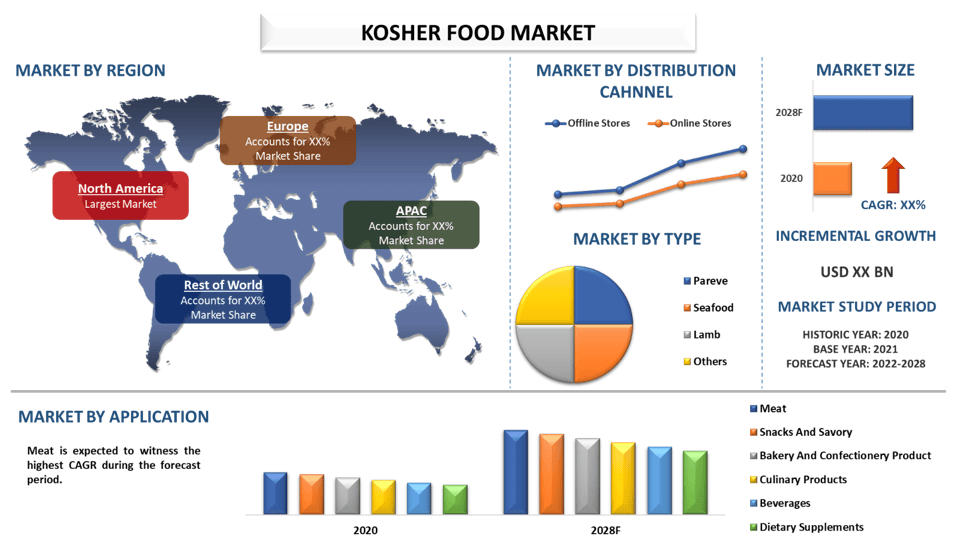- Home
- About Us
- Industry
- Services
- Reading
- Contact Us
Kosher Food Market: Current Analysis and Forecast (2022-2028)
Emphasis on Type (Pareve, Seafood, Lamb, Others); Application (Culinary Products, Snacks and Savory, Bakery and Confectionery Product, Meat, Beverages, Dietary Supplements); Distribution Channel (Offline Stores, Online Stores); Region/Country

The kosher food market is expected to register a CAGR of approx. 4% over the period of 2021-2027. Kosher foods are foods and drinks that the Jewish diet allows people to eat. It’s not a cooking style. Not all Jews are Kosher, and Kosher foods are not unique to Jews. Scholars believe that the Jewish diet may be the first known food law. The general principles of keeping are contained in the law, which is part of the Jewish Bible. There is a commandment (called Mitzvah) that must be obeyed in order to obey God. Staying in Kosher is one of them. The rising demand for kosher food is because of the rise in demand for high-quality and safer food products among various consumers. In addition, the rising prevalence of lactose intolerance in the population is contributing to the growth of the kosher food market. For instance, according to MEDLINE Plus, approximately 65 percent of the human population has a reduced ability to digest lactose after infancy. Lactose intolerance in adulthood is most prevalent in people of East Asian descent, with 70 to 100 percent of people affected in these communities. Furthermore, the high demand for growing proclivity of ethically sourced and locally sourced ingredients and increasing health awareness, and changing lifestyles are expected to drive the market.
Bob’s Red Mill, CARGILL INC., Conagra Brands Inc., Dean Foods, Empire Kosher, Nestle S A, The Hain Celestial Group, Inc. (Hain Celestial), PepsiCo (Tropicana), Unilever plc, GENERAL MILLS INC. (YOPLAIT). are some of the key players in the market. Several M&As along with partnerships have been undertaken by these players to facilitate customers with kosher food.
Insights Presented in the Report
“Amongst Type, the pareve category accounted for the majority share in the market in 2020”
Based on type, the market is classified into pareve, seafood, lamb, and others. Amongst types, the pareve category accounted for a significant share in the market. The adoption of kosher pareve certified products is becoming more popular among individuals driving the segment growth. Further, the rising demand for high-quality natural food products that also provides a gluten-free diet is further anticipated to drive the demand for kosher foods.
“Among Application, the meat is expected to witness highest CAGR during the forecast period”
Based on application, the market is categorized into culinary products, snacks, and savory, bakery and confectionery products, meat, beverages dietary supplements. Among these, the meat is expected to witness the highest CAGR during the forecast period owing to the consumption of kosher foods by non-Jewish consumers, own-branded suppliers reaching major market players, and a surge in demand for kosher-certified frozen meat products from various consumers in all the regions.
“Among Distribution Channel, the offline stores is expected to witness highest CAGR during the forecast period”
Based on end-users, the market is categorized into offline stores and online stores. Among these, the offline stores are expected to witness the highest CAGR during the forecast period owing to the increase in retail sales channel penetration in developing markets.
“North America to witness significant growth during the forecast period”
For a better understanding of the market dynamics of the kosher food market, a detailed analysis was conducted for different regions across the globe including North America (the U.S, Canada, and the Rest of North America), Europe (Germany, France, Spain, United Kingdom, Italy, and Rest of Europe), Asia-Pacific (China, India, Australia, Japan, and Rest of APAC), Rest of World has been conducted. North America constitutes a major market for the kosher food market industry and generated revenue in 2020 owing to well-established market players and increased demand from the food & beverage industry in the region.
Reasons to buy this report:
- The study includes market sizing and forecasting analysis validated by authenticated key industry experts.
- The report presents a quick review of overall industry performance at one glance.
- The report covers an in-depth analysis of prominent industry peers with a primary focus on key business financials, product portfolio, expansion strategies, and recent developments.
- Detailed examination of drivers, restraints, key trends, and opportunities prevailing in the industry.
- The study comprehensively covers the market across different segments.
- Deep dive regional level analysis of the industry.
Customization Options:
Global kosher food market can further be customized as per the requirement or any other market segment. Besides this, UMI understands that you may have your own business needs, hence feel free to connect with us to get a report that completely suits your requirements.
Table of Content
Research Methodology for the Global Kosher Food Market Analysis (2022-2028)
Analyzing the historical market, estimating of the current market, and forecasting the future market of the global kosher food market were the three major steps undertaken to create and analyze the adoption of kosher food in major regions globally. Exhaustive secondary research was conducted to collect the historical market numbers and estimate the current market size. Secondly, to validate these insights, numerous findings and assumptions were taken into consideration. Moreover, exhaustive primary interviews were also conducted, with industry experts across the value chain of the global kosher food market. Post assumption and validation of market numbers through primary interviews, we employed a top-down/bottom-up approach to forecasting the complete market size. Thereafter, market breakdown and data triangulation methods were adopted to estimate and analyze the market size of segments and sub-segments the industry pertains to. Detailed methodology is explained below:
Analysis of Historical Market Size
Step 1: In-Depth Study of Secondary Sources:
Detail secondary study was conducted to obtain the historical market size of the kosher food market through company internal sources such as annual report & financial statements, performance presentations, press releases, etc., and external sources including journals, news & articles, government publications, competitor publications, sector reports, third-party database, and other credible publications.
Step 2: Market Segmentation:
After obtaining the historical market size of the kosher food market, we conducted a detailed secondary analysis to gather historical market insights and share for different segments & sub-segments for major regions. Major segments included in the report as type, application, and distribution channel. Further country-level analyses were conducted to evaluate the overall adoption of testing models in that region.
Step 3: Factor Analysis:
After acquiring the historical market size of different segments and sub-segments, we conducted a detailed factor analysis to estimate the current market size of the kosher food market. Further, we conducted factor analysis using dependent and independent variables such as various types, applications, and distribution channels of kosher food. A thorough analysis was conducted for demand and supply-side scenarios considering top partnerships, merger and acquisition, business expansion, and product launches in the kosher food market sector across the globe.
Current Market Size Estimate & Forecast
Current Market Sizing: Based on actionable insights from the above 3 steps, we arrived at the current market size, key players in the global kosher food market, and market shares of the segments. All the required percentage shares split, and market breakdowns were determined using the above-mentioned secondary approach and were verified through primary interviews.
Estimation & Forecasting: For market estimation and forecast, weights were assigned to different factors including drivers & trends, restraints, and opportunities available for the stakeholders. After analyzing these factors, relevant forecasting techniques i.e., the top-down/bottom-up approach were applied to arrive at the market forecast for 2028 for different segments and sub-segments across the major markets globally. The research methodology adopted to estimate the market size encompasses:
- The industry’s market size, in terms of revenue (USD) and the adoption rate of the kosher food market across the major markets domestically
- All percentage shares, splits, and breakdowns of market segments and sub-segments
- Key players in the global kosher food market in terms of solutions offered. Also, the growth strategies adopted by these players to compete in the fast-growing market
Market Size and Share Validation
Primary Research: In-depth interviews were conducted with the Key Opinion Leaders (KOLs) including Top Level Executives (CXO/VPs, Sales Head, Marketing Head, Operational Head, Regional Head, Country Head, etc.) across major regions. Primary research findings were then summarized, and statistical analysis was performed to prove the stated hypothesis. Inputs from primary research were consolidated with secondary findings, hence turning information into actionable insights.
Split of Primary Participants in Different Regions

Market Engineering
Data triangulation technique was employed to complete the overall market estimation and to arrive at precise statistical numbers for each segment and sub-segment of the global kosher food market. Data was split into several segments & sub-segments post studying various parameters and trends in the areas of type, application, and distribution channel in the global kosher food market.
The main objective of the Global Kosher Food Market Study
The current & future market trends of the global kosher food market were pinpointed in the study. Investors can gain strategic insights to base their discretion for investments on the qualitative and quantitative analysis performed in the study. Current and future market trends were determined the overall attractiveness of the market at a regional level, providing a platform for the industrial participant to exploit the untapped market to benefit from a first-mover advantage. Other quantitative goals of the studies include:
- Analyze the current and forecast market size of the kosher food market in terms of Value (USD). Also, analyze the current and forecast market size of different segments and sub-segments
- Segments in the study include areas of type, application, and distribution channel
- Define and analysis of the regulatory framework for the kosher food market industry.
- Analyze the value chain involved with the presence of various intermediaries, along with analyzing customer and competitor behaviors of the industry.
- Analyze the current and forecast market size of the kosher food market for the major region.
- Major countries of regions studied in the report include Asia Pacific, Europe, North America, and the Rest of the world.
- Company profiles of the kosher food market and the growth strategies adopted by the market players to sustain in the fast-growing market
- Deep dive regional level analysis of the industry
Related Reports
Customers who bought this item also bought










